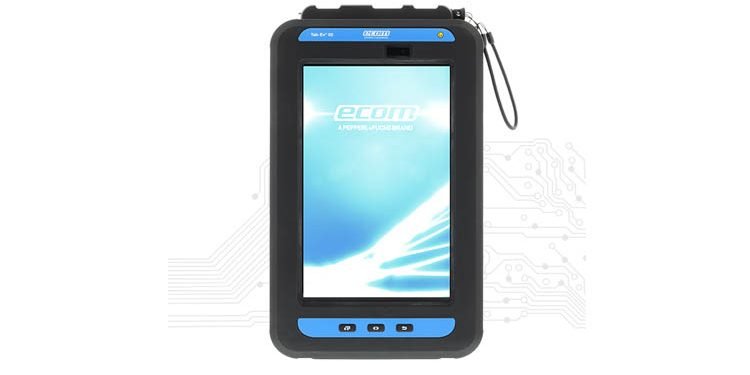ECOM Introduces its Remote Device Management Solution
Smooth service for mobile devices in hazardous areas
The deployment, configuration and continuous updating of mobile devices in companies requires a lot of time and resources. Digital Services for staging, mobile device management and device analytics help to speed up and simplify these processes.
It is hard to imagine today’s working environment without mobile devices. Especially in the field, mobile access to data, sharing of field data via the corporate network and reliable accessibility are important requirements for smooth processes as well as employee’s safety. The use of mobile devices in industrial plants is linked to company-wide guidelines regarding their configuration, integration into the company network, software and last but not least data security. Ideally, they should be deployed immediately and updated just-in-time
Digital services that combine automated staging, device analytics and mobile device management (MDM) can help to overcome this challenge. An MDM system, for example, provides a centralized management of mobile devices. This includes the inventory of mobile devices in organizations, the distribution of software, data and guidelines as well as the protection of data on these devices. Typical solutions include a server component that sends administrative commands to the mobile devices and a client component that runs on the administered device that receives and implements the administrative commands. Deploying an MDM system optimizes the functionality and security of mobile devices within an organization while simultaneously protecting the closed communications network. Therefore, MDM systems must meet a number of requirements.
Seamless support for the end user
A well designed MDM system starts with the deployment and configuration of the mobile devices. On request, the Pepperl+Fuchs brand ecom delivers tablets and smartphones with customized configurations directly from the factory – to different locations and end users worldwide. All security and WLAN settings as well as pre-definable applications for daily use in industrial plants and hazardous areas can be pre-installed. This not only enables global rollouts but also makes them significantly faster and more cost-effective. Error-prone manual configurations are just as much a thing of the past as various device settings.
Providers like ecom also support the zero-touch registration of Android™ (AZT). This allows Android devices to be deployed quickly, easily and on-demand, with management settings and applications fully customized to the individual employee’s needs. This ensures smooth and quick processes. Restricting user access to only authorized applications further increases security. Log-in, provisioning, configuration and management of the devices are possible individually or over-the-air as a group. This also simplifies and accelerates processes.
Keeping devices always up-to-date
An important part of the sustainable use of mobile devices in companies is a continuous supply of up-to-date software and its smooth implementation on the corresponding devices. In order to guarantee updates during normal operation, MDM systems have a “silent” installation, which enables the company’s IT to carry out updates remotely in the background and without active user intervention. This is especially beneficial for companies where the IT department is isolated from the end users as they work in different locations. The only other option is sending the devices back and forth on a regular basis, which is time-consuming and inefficient, or letting the employees install updates on their own, risking them not being carried out correctly. “Silent” installations eliminate these risks. The continuous compliance with IT security standards must also be taken into account. To achieve this, mobile devices should be lockable for private applications or business apps should only be accessible in a closed and specially secured area on the mobile device. In addition, a regular supply of security patches and updates for the devices must be ensured.
Failure protection thanks to continuous monitoring
Even well-maintained equipment may be defective due to external influences or due to simple wear and tear. Therefore continuous monitoring of the devices by the IT is indispensable. Proactive alerts and audit reports on the compliance status of equipment help prevent downtime.
With the remote device management functions Device Diagnostics and Device Analytics, ecom provides two solutions which allow the company’s IT to permanently monitor the current status of mobile devices. This way, malfunctions can be remedied preventively or directly. Updates during operation are also possible. The live visualization of network coverage allows administrators to recognize and track critical software events and software installations by the user. Causalities can be generated via a statistical accumulation of events and correlations – for instance between geographical data, WLAN coverage and software errors.
Enterprise solution with useful functional extensions
Digital solutions like MDM systems ensure that all devices maintain the same quality. Software upgrades as well as functional enhancements are an additional important advantage. Individual user profiles can also be set up. This allows the start and end of the work shift to be displayed, as well as apps, tasks and alarms to be set, for example if a particular piece of work equipment such as ear protection is missing. Ecom also provides other optional services like eSentinel, a classic single worker protection solution with alarm function. eBarcode, in turn, offers a professional software solution for data collection. This increases employee productivity and security.
An investment in digital solutions is particularly beneficial for companies that place a wide range of demands on their mobile devices. Digital services and mobile devices must be understood as a holistic system. This system consists of central hardware, closely coordinated peripherals, supporting software and the appropriate platform that is completely tailored to the needs of the user and can be configured modularly for future challenges.

